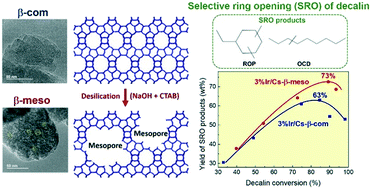High-performing Ir- and Pt-containing catalysts based on mesoporous beta zeolite for the selective ring opening of decalin†
Abstract
Selective ring opening (SRO) of naphthenic molecules resulting from the hydrogenation of polyaromatics is a desirable catalytic route for upgrading low-quality diesel fractions such as hydrotreated light cycle oil (LCO) produced in catalytic crackers. In this work, catalysts based on either Ir or Pt (∼3 wt%) dispersed on a Cs+-exchanged mesoporous beta zeolite (β-meso) obtained by controlled desilication of a commercial beta sample (β-com, Si/Al = 18) with NaOH in the presence of a CTAB surfactant were prepared and evaluated for the SRO of decalin as a model reactant. In comparison to an equivalent Ir catalyst based on the commercial zeolite (Ir/Cs-β-com), the Ir catalyst based on mesoporous beta (Ir/Cs-β-meso) attained higher decalin conversions and yields of target ring opening products (C10-alkylcycloalkanes, ROP, and C10-alkanes or open chain decanes, OCD). An unprecedented maximum combined yield of ROP + OCD of 72.6 wt% was achieved over the Ir/Cs-β-meso catalyst at 89.2% decalin conversion. The improved catalytic performance exhibited by the catalyst based on mesoporous beta zeolite can be mainly ascribed to an increased accessibility of decalin molecules to the active sites and to a faster diffusion of ring opening products, retarding their further conversion into unwanted lighter (C9−) hydrocarbons. On the other hand, the catalyst based on Pt dispersed on Cs-β-meso was less active and achieved a lower maximum combined yield of ROP + OCD (59.6 wt% at 92.7% conversion) than its homologous catalyst based on Ir. However, compared to the Ir catalyst, less branched ROP and OCD isomers (hence, more desirable from the viewpoint of cetane) were formed on the Pt catalyst. The molecular structure of the main ROP and OCD isomers, as assessed by GC × GC, and the carbon number distribution of C9− products indicated that cleavage of C–C bonds on the Ir-based catalysts predominantly occurred at Ir centers via the (non-selective) dicarbene hydrogenolysis mechanism. Differently, both the hydrogenolysis (via the multiplet or selective mechanism) and the bifunctional (via carbocations) pathways contributed to the breaking of C–C bonds on the Pt-based mesoporous catalyst.



 Please wait while we load your content...
Please wait while we load your content...